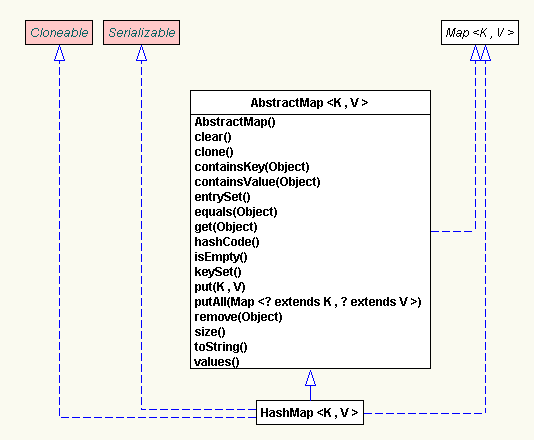Set
中的元素為什么不允許重復
??????
版權所有,轉載請聲明出處
zhyiwww@163.com
?
為了弄清楚這個問題
,
我又看了一遍
Collection
部分
,
并且看了些其中的源碼
,
覺得對其中的實現又明白了一點
,
現在說出來和大家共享
.
我們先看一下
Set
類的關系圖:

現在我們就從
Set
說起。
Set
接口為我們提供了一個
add()
方法,以讓我們添加元素。所以我們看一下在其實現類
HashSet
中是如何實現的呢?
我們看
HashSet
中的
add()
方法實現;
??? public boolean add(
E o
) {
??????
?????? return?
map.put(o, PRESENT)==null;
}
你可能回問怎么回出來
map
了呢?
Map
又是一個什么變量呢?
我們來看
map
是在在哪定義的。原來,在
HashSet
中定義了這樣的兩個變量:
??? private transient HashMap<E,Object> map;
??? private static final Object PRESENT = new Object();
我們再看一下上面的
add()
方法。
map.put(o, PRESENT)==null
實際執行的是
map
的方法,并且我們添加的對象是
map
中的
key,value
是執行的同一個對象
PRESENT.
因為map中的key是不允許重復的,所以set中的元素不能重復。
?
下面我們再看一下,
map
又是如何保證其
key
不重復的呢?
?
現在我們看一下
map
中的
put()
方法的實現:
HashMap
實現了
map
,在
HashMap
中是這樣實現的:
??? public V put(K key, V value) {
????? K k = maskNull(key);
??????? int hash = hash(k);
??????? int i = indexFor(hash, table.length);
??????? for (Entry<K,V> e = table[i]; e != null; e = e.next) {
??????????? if (e.hash == hash && eq(k, e.key)) {
??????????????? V oldValue = e.value;
??????????????? e.value = value;
??????????????? e.recordAccess(this);
??????????????? return oldValue;
??????????? }
??????? }
?
??????? modCount++;
??????? addEntry(hash, k, value, i);
??????? return null;
??? }
我們我們按照方法的執行一步一步的來看一下,其實現的過程。
K k = maskNull(key);
這一步是要判斷當前的要添加的對象的
key
是否為空,如果為空的話,那么就生成一個新的對象作為其
key
。實現如下:
??? static final Object NULL_KEY = new Object();
???? * Returns internal representation for key. Use NULL_KEY if key is null.
??? static <T> T maskNull(T key) {
??????? return key == null ? (T)NULL_KEY : key;
??? }
之后
int hash = hash(k);
我們看一下
hash()
方法的實現:
??? static int hash(Object x) {
??????? int h = x.hashCode();
??????? h += ~(h << 9);
??????? h ^=? (h >>> 14);
??????? h +=? (h << 4);
??????? h ^=? (h >>> 10);
??????? return h;
??? }
這一步其實是要得到當前要添加對象的
hashcode,
方法中,首先通過
int h = x.hashCode()
取得了當前的要添加對象的
hashcode,
然后
??????? h += ~(h << 9);
??????? h ^=? (h >>> 14);
??????? h +=? (h << 4);
??????? h ^=? (h >>> 10);
生成一個新的
hashcode.
接著執行的是
(從此處開始,我理解的比較膚淺,請看到此出的朋友多多指點)
int i = indexFor(hash, table.length);
這個方法是要
Returns index for hash code h.
??? static int indexFor(int h, int length) {
??????? return h & (length-1);
??? }
?????
下面就要根據
hashmap
中的元素逐個的比較,看是否相同,如果不同就回添加一個新的元素。是通過循環判斷來實現的。
??????? for (Entry<K,V> e = table[i]; e != null; e = e.next) {
??????????? if (e.hash == hash && eq(k, e.key)) {
??????????????? V oldValue = e.value;
??????????????? e.value = value;
???????????????
e.recordAccess(this);
這句我的理解是:在內存中的可以訪問元素又多了一個。也就是說,添加之后,可以通過hashmap來訪問此元素了。
????????
???????return oldValue;
??????????? }
??????? }
通過循環判斷是否有完全相同的對象,包括
hashcode
和
value
值。如果已經存在就返回其值,如果不存在就執行一下操作。
??????? modCount++;
??????? addEntry(hash, k, value, i);
??????? return null;
對象不存在,首先修改
hashmap
的修改次數,即
modCount
加
1.
然后將對象添加到數組中。
??? void addEntry(int hash, K key, V value, int bucketIndex) {
????? Entry<K,V> e = table[bucketIndex];
??????? table[bucketIndex] = new Entry<K,V>(hash, key, value, e);
??????? if (size++ >= threshold)
??????????? resize(2 * table.length);
}
仍然是數組,我們來看一下
,
在
hashmap
中用來存放對象的數組的定義:
??
?transient Entry[] table;
至此,我想大家也許應該明白了,為什么在
set
中是不允許存放重復值的。
通過才的分析,我們可以看到,
map
的一些特征:
1.??????
在
map
中也是不能存放完全相同的元素的
2.??????
如果你存入的對象的
key
值已經存在的話,那么新的
value
將會取代老的
value
值,但是并不會添加新的元素進去。
我們可以通過一個測試程序來證明這一點:
? public void mapTest() {
??? Map m = new HashMap();
??? /**
???? * we? can? put? the? int? 1 and the? value? 1? into? the? map
???? * but? we? cannot? get? the? 1 as? int? from the map
???? * why ?
???? * we? only? get? the? 1? as? integer? from? the map,
???? * so? we? only? get the object? from the map,if we? put the? value? into
???? * the map,we? will get one? instance of? the wrapper? of? that
???? */
??? m.put(1, 1);
??? //int i = m.get(1);
??? Integer i = (Integer) m.get(1);
??? System.out.println(i);
?
??? m.put(1, 1);
??? m.put(1, 1);
??? System.out.println("map?? :??? " + m);
??? System.out.println("map? size??? :?? " + m.size());
??? m.put(1, 2);
??? System.out.println("map?? :??? " + m);
??? System.out.println("map? size??? :?? " + m.size());
? }
運行的結果是:
map?? :??? {1=1}
map? size??? :?? 1
map?? :??? {1=2}
map? size?? ?:?? 1
希望此文能大家有所幫助。
|----------------------------------------------------------------------------------------|
版權聲明 版權所有 @zhyiwww
引用請注明來源 http://www.tkk7.com/zhyiwww
|----------------------------------------------------------------------------------------|
posted on 2006-03-30 09:41
zhyiwww 閱讀(3660)
評論(0) 編輯 收藏 所屬分類:
java basic